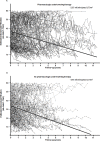Urate-lowering agents for asymptomatic hyperuricemia in stage 3 - 4 chronic kidney disease: Controversial role of kidney function
- PMID: 31206563
- PMCID: PMC6576756
- DOI: 10.1371/journal.pone.0218510
Urate-lowering agents for asymptomatic hyperuricemia in stage 3 - 4 chronic kidney disease: Controversial role of kidney function
Abstract
Because the serum uric acid level increases as the glomerular filtration rate (GFR) decreases, hyperuricemia is associated with chronic kidney disease (CKD). Although hyperuricemia is a risk factor for CKD progression, the causal role of uric acid remains controversial in patients with CKD and asymptomatic hyperuricemia. This study included 588 patients with stage 3-4 CKD and asymptomatic hyperuricemia. Using propensity score matching, 165 pairs treated and untreated with pharmacologic urate-lowering therapy were matched. Kaplan-Meier curves were constructed to determine the effect of urate-lowering agents on kidney survival. The prognostic value for kidney survival was ascertained using Cox regression analysis. The GFR changes over time between the patients treated and untreated with urate-lowering agents were assessed using a linear mixed model analysis. The mean age of the matched patients was 63.2 ± 12.7 years, and 52 (15.8%) patients had diabetic nephropathy. The mean estimated GFR (eGFR) and serum uric acid level were 36.7 mL/min/1.73 m2 and 7.8 mg/dL, respectively. During a mean follow-up period of 41.9 months, 87 developed end-stage kidney disease (ESKD). The incidence rates of ESKD were comparable between the patients treated and untreated with urate-lowering agents. The Kaplan-Meier analysis indicated that kidney survival was also comparable between them. In the multivariate analysis, heart failure and low eGFR were the significant prognostic factors for kidney survival. However, pharmacologic urate-lowering therapy was not predictive of kidney survival. The overall GFR decline rate was also comparable between the groups (P = 0.13). The efficacy of pharmacologic urate-lowering therapy in delaying CKD progression remains controversial. Therefore, further randomized controlled trials are needed to confirm its efficacy in attenuating kidney function deterioration in patients with stage 3-4 CKD.
Conflict of interest statement
The authors have declared that no competing interests exist.
Figures



Similar articles
-
Febuxostat Therapy for Patients With Stage 3 CKD and Asymptomatic Hyperuricemia: A Randomized Trial.Am J Kidney Dis. 2018 Dec;72(6):798-810. doi: 10.1053/j.ajkd.2018.06.028. Epub 2018 Sep 1. Am J Kidney Dis. 2018. PMID: 30177485 Clinical Trial.
-
Hyperuricemia has increased the risk of progression of chronic kidney disease: propensity score matching analysis from the KNOW-CKD study.Sci Rep. 2019 Apr 30;9(1):6681. doi: 10.1038/s41598-019-43241-3. Sci Rep. 2019. PMID: 31040373 Free PMC article.
-
Hyperuricemia and Progression of CKD in Children and Adolescents: The Chronic Kidney Disease in Children (CKiD) Cohort Study.Am J Kidney Dis. 2015 Dec;66(6):984-92. doi: 10.1053/j.ajkd.2015.06.015. Epub 2015 Jul 21. Am J Kidney Dis. 2015. PMID: 26209544 Free PMC article.
-
Recent evidence on the effect of urate-lowering treatment on the progression of kidney disease.Curr Opin Nephrol Hypertens. 2021 May 1;30(3):346-352. doi: 10.1097/MNH.0000000000000699. Curr Opin Nephrol Hypertens. 2021. PMID: 33767063 Review.
-
Effect of Urate-Lowering Therapy on Cardiovascular and Kidney Outcomes: A Systematic Review and Meta-Analysis.Clin J Am Soc Nephrol. 2020 Nov 6;15(11):1576-1586. doi: 10.2215/CJN.05190420. Epub 2020 Oct 14. Clin J Am Soc Nephrol. 2020. PMID: 33055192 Free PMC article.
Cited by
-
Bioactive Compounds from Plant-Based Functional Foods: A Promising Choice for the Prevention and Management of Hyperuricemia.Foods. 2020 Jul 23;9(8):973. doi: 10.3390/foods9080973. Foods. 2020. PMID: 32717824 Free PMC article. Review.
-
Constituents and Anti-Hyperuricemia Mechanism of Traditional Chinese Herbal Formulae Erding Granule.Molecules. 2019 Sep 6;24(18):3248. doi: 10.3390/molecules24183248. Molecules. 2019. PMID: 31489932 Free PMC article.
-
Hyperuricemia is associated with secondary hyperparathyroidism in patients with chronic kidney disease.Int Urol Nephrol. 2022 Sep;54(9):2255-2261. doi: 10.1007/s11255-022-03116-5. Epub 2022 Jan 31. Int Urol Nephrol. 2022. PMID: 35099689
-
Uric Acid Correlates with Serum Levels of Mineral Bone Metabolism and Inflammation Biomarkers in Patients with Stage 3a-5 Chronic Kidney Disease.Medicina (Kaunas). 2024 Dec 19;60(12):2081. doi: 10.3390/medicina60122081. Medicina (Kaunas). 2024. PMID: 39768960 Free PMC article.
-
Multiparametric MRI analysis for the evaluation of renal function in patients with hyperuricemia: a preliminary study.BMC Med Imaging. 2021 Sep 28;21(1):139. doi: 10.1186/s12880-021-00675-4. BMC Med Imaging. 2021. PMID: 34583652 Free PMC article.
References
-
- Wu XW, Muzny DM, Lee CC, Caskey CT. Two independent mutational events in the loss of urate oxidase during hominoid evolution. J Mol Evol. 1992;34:78–84. . - PubMed
Publication types
MeSH terms
Substances
LinkOut - more resources
Full Text Sources
Other Literature Sources
Medical
Research Materials
Miscellaneous

